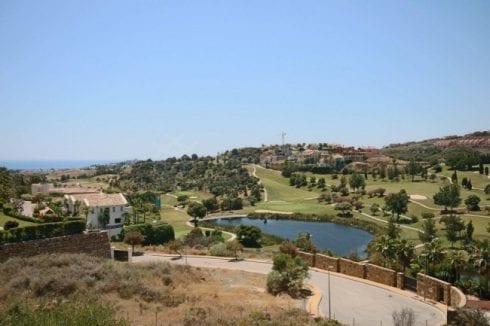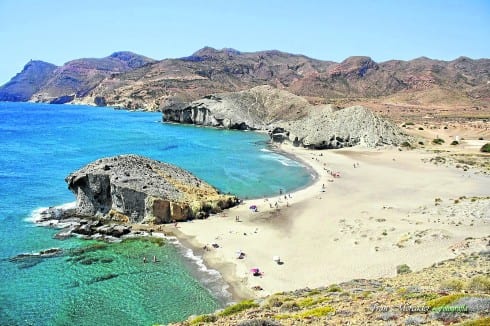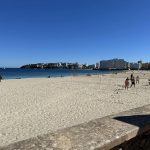 DRIVING over the coastal mountains from the Almerian tourist trap of Mojácar to Carboneras is a delight.
DRIVING over the coastal mountains from the Almerian tourist trap of Mojácar to Carboneras is a delight.
You pass through the hamlet of Sopalmo, which sits in tiny splendour over a sandy track that leads drowsily down to the sea, a mile away. Here is one of only two places in Spain where you can find chameleons. Cristobal has a small restaurant there and will fill you up for €10 while the kids go exploring with their butterfly nets.
We are at the edge of the gigantic – and generally rather empty – Natural Park of Nijar/ Cabo de Gata.
But before the large municipality of Nijar, increasingly covered with ‘plastic farms’, we must pass through Carboneras, the ugly fishing town made famous by the Algarrobico Hotel.
It’s been over a decade since a judge ruled that it was illegally built on a beach inside a natural park. Now, after millions spent on legal fees and hundreds of stories, it is finally to be knocked down.
The curving road passes the hill of the ‘Moors Blood’ – a colourful slab of streated rock where a battle may have taken place half a millennium ago – and zigzags towards the highest part of the route towards Carboneras, with crags on one side and alarming drops on the other: a road straight out of The Italian Job – or, perhaps the perfect final scene for Thelma and Louise.
At the top, there’s a small parking area, liberally decorated with graffiti, where you can see for miles. My camera records an empty dry mountain, a rugged coast, clean blue sea and – off to the southwest – the back of a monstrous hotel, several miles away and far below.
The only plant-life in this – and most – of the Parque Natural is scrub: no doubt of huge environmental value to our friends the ecologists but, dress it how you will, it’s scrub none the less.
The ecologists are simple city folk. They live through subsidies, European funds and obscure publications. They are like the Caliban of Shakespeare: rude destructive fellows, who flow out from their apartments in the suburbs to deal harshly with the countryside, subsidised by the gullible politicians from far-off Seville.
In Almería, the ecologists must ignore the 350 km2 tract of plastic farms, which do huge damage to the environment but bring much wealth. They will spend their time – and what European funds they can attract – on such foolishness as ripping up a small plantation of agave outside the city, a plantation that has been there for almost a century.
The plants, they say, are invasive. So too, they say, are the prickly pear cactus (brought to Spain by the conquistadores) – as the entire south east of Spain is plagued by an unstoppable cactus fly. The local tortoise must be protected, they insist (again, with European backing) so the harmless creatures are collected and sent to prison camps in the high sierras, where they solemnly die of the flu.
A French businessman told me 20 years ago: ‘In the next century, the two growth industries will be tourism and ecology’. Ten years later, in small and ugly town in Almería, the two forces finally declared war.
As the car breasts the final hill on the route to Carboneras , the rear of the ghastly hotel becomes visible again: surrounded by land prepared by the builder for shops, restaurants and an urbanisation of 250 villas (land, incidentally, which does not fall within the new frontier of the Natural Park, and is thus still theoretically viable).
These days, sightseers come to see the hotel. Aghast, they take pictures: perhaps they’ll stay for lunch in the town. Nearby is the small villa where Peter O’Toole stayed when filming part of David Lean’s Lawrence of Arabia. Just past the Algarrobico, on the other side, is the dry river bed where the Arab horsemen attacked Aqaba in that furious cinematographic gallop.
Carboneras is a reasonably well-off, if unusually ugly fishing town. It has three ports – commercial, touristic and industrial – some nice beaches, good fish restaurants, a huge power station responsible for producing 25% of all the CO2 that is clogging up the air in Andalucía, a vast and inoperable sports stadium and an unemployment rate of only 20% (Almería province has 25%).
Opening the Algarrobico and finishing off the surrounding satellite urbanisation would have brought many jobs to the town. But as a Greenpeace spokesman said after the latest judgement, ‘they can always help work on the demolition’.
The reality is that after 10 years of rotting in the sun and open to the elements, the 20-storey hotel would have been almost impossible to finish. Its time had come. But, what about the costs involved in demolition – money that could have been better spent? The politicians speak blithely of returning the several hundred metres of empty rocky scree back to how it was – but how impossible is that? And is it even worth the effort?
The justification for the demolition comes from a rule that you can’t build in a national park, even though the hotel was not in a national park when work began; indeed, the promoters bought the land from the Junta (through a public company called Soprea) in 1999, when it was still ‘urbanisable’. The boundaries were subsequently moved as the PP in Madrid changed the coastal building limits.
In 2006, the project which had previously won the blessing of the then Junta President, Manuel Chaves, fell foul of Environment Minister Cristina Narbona who ordered work stopped when the hotel was 90% complete: it was being built on public land.
Almería is a large province of 8,000 km2, of which 3,100 km2 are protected – about 35% of the entire province. We are talking here of perhaps one hectare. Couldn’t Almería afford to lose a tiny fraction of its empty, unvisited and largely pointless parkland to help create some jobs?
A recent interview with the President of the Superior Court of Justice in Andalucía says that ‘judges sometimes contradict themselves – we are human and can also get things wrong’. A spokesman for ‘Salvemos Mojacar’ does not suffer from the same doubts: ‘it must be demolished and the promoter should not be reimbursed by as much as one centimo’ (they seek €70 million).
So, as sometimes happens in Spain: the building can never be completed, and it can never be entirely demolished. Jobs are lost in an area of high unemployment, and a rotting and monstrous hulk of a building will perhaps be turned one day, after at least a decade of uselessness, into a mountain of rubble.
Perhaps the rabbits, its future residents, will be pleased.












A good article Lenox, which goes some way to explain how Andalucia got into the terrible state it is in today and why a bunch of waste of space ecologists have such a loud voice. It was this same nasty minority group who aided and abetted the Junta de Andalucia in the most expensive demolition in history, Helen and Len Prior’s house.
I’m sure the so called ecologists have got all the answers to Spain’s unemployment woes and will come up with some really innovative regeneration schemes – not.
The learning curve for competent, democratic decision-making and environmental protection is steep. Left intact, the Algarrobico monstrosity would be a monument to all that is bad about urban planning and regional government: corrupt officials, lack of knowledge, incompetent design technology, environmental indifference. Attempting to justify this heap of rubble – in either its current or finished state – as a ‘job creator’, and not significant enough to warrant itscomplete removal and, finally, coastal restoration, is at odds with good governance in the public’s interest. Messes are always more complicated to clean up than to prevent. That is why we want experienced, well-trained, honest university personnel in planning and other governing positions.
Useless conservationists aside, I’m with the rabbits on this one. The issue is not just the monstrosity itself, it’s the corruption and abuse of law that allowed this project to near completion that requires it to now be demolished. The owners of this hotel would doubtless have profited massively from this illegal venture, and now they will not. That is some consolation. Someone has to pay for demolition and it should not be the taxpayer. The tragedy of this event was that it was allowed to be built for so many years without the rule of law stopping it. Too little, too late. Spain in a nutshell.
I couldn’t agree more and I doubt that any lessons will be learnt unfortunately.
A similar situation seems to be arising in the parcel of land next to Estepona Marina where even though it is coastal land there are still plans, which are supported by the Ayuntamiento, to build 3 eight storey apartment buildings plus penthouses and parking and also 4 areas of locales totaling in excess of 35,000 m2 right next to one of the most beautiful beaches on the Costa de Sol, Playa del Cristo.
The environmental damage that could be caused would be irreversible and regretted by generations.
Pretty decent article – unlike most of the lies and emotional eco-trash written about this project. First of all, it is important to remember that when the hotel project began construction began it had been LEGALLY reviewed by the official Spanish authorities in power at the time and was fully approved and had received all the correct legal permissions. At which point, the private investor (not some Dr. Evil type) began to spend his hard earned millions to construct the hotel, buy materials, employ people, etc., – again all done LEGALLY! It was only when there was a change in local POLITICS that the legal land was then somehow deemed illegal! The real culprits in this waste of time, money and jobs is once again the corrupt and crazy Spanish politics, not the developer. He DID NOT BREAK the LAW. As for the costs involved in a possible demolition of the 90% completed hotel, those costs should be paid by the politicians who granted the permissions to build it in the first place, and also by those who then arbitrarily changed the law with any risk of consequence! I believe they should also be held responsible for reimbursing the developer for the costs he has incurred because of their incompetence or corruption, or both! Imagine if you had submitted all the architectural plans, designs, etc., to the local authorities to build your home. Then you spent all of that money to do so, and just when you were 90% complete, some new politicians came to power – changed the rules and said you now have to destroy your home at your expense. And you will not be reimbursed for any of the money you spent? Ignore the eco-hype and starving polar bear baloney, and this tragedy is exactly the same.